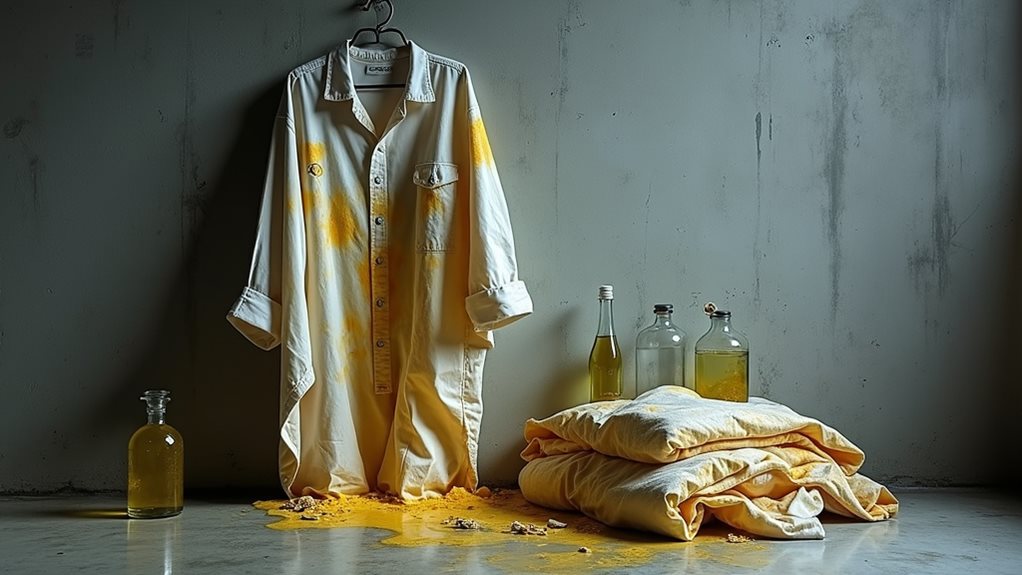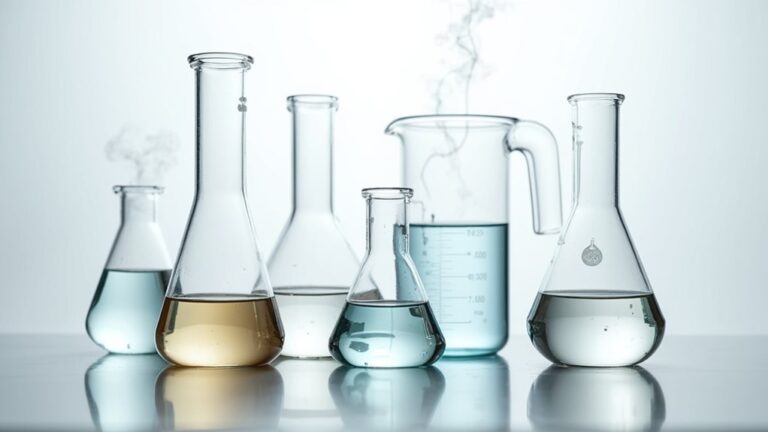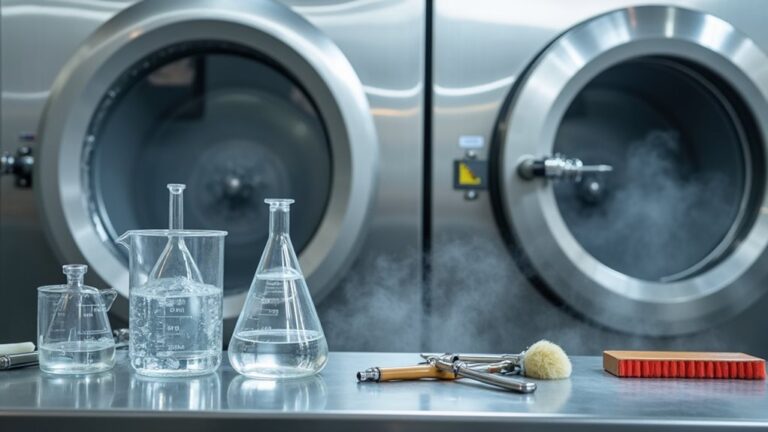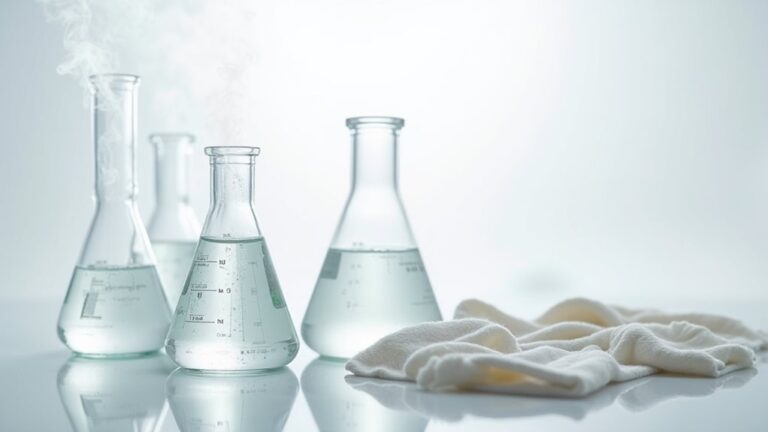You’re absolutely right to be concerned about dry cleaning – those “fresh” clothes you’re bringing home are actually saturated with perchloroethylene, a probable carcinogen that’s been linked to liver damage, neurological problems, and increased cancer risks. Every time you hang those garments in your closet, you’re exposing yourself and your family to toxic vapors that can cause headaches, skin irritation, and respiratory issues, while simultaneously contributing to groundwater contamination that affects entire communities. The good news is that most fabrics labeled “dry clean only” can actually be safely washed at home using gentle techniques, and discovering these alternatives will transform how you care for your wardrobe.
Toxic Chemicals in Dry Cleaning Solvents
The invisible danger lurking in your freshly pressed blazer might surprise you, but those crisp, clean clothes come with a toxic price tag that extends far beyond your wallet.
When you drop off your favorite suit at dry cleaners, you’re unknowingly entering a world where toxic chemicals reign supreme, and perchloroethylene (perc) sits on the throne like an unwelcome monarch.
This colorless solvent, along with its equally nasty cousin trichloroethylene, creates serious health concerns that’ll make your head spin faster than a washing machine on steroids 🌪️.
These environmentally unfriendly chemicals don’t just vanish after cleaning—they cling to your clothes like that one friend who overstays their welcome, exposing you to cancer-causing compounds every time you wear those “clean” garments.
The EPA has classified PERC as a probable human carcinogen, linking it to neurological problems, liver damage, and reproductive issues that pose particular risks to pregnant women and children.
Health Risks for Workers and Customers
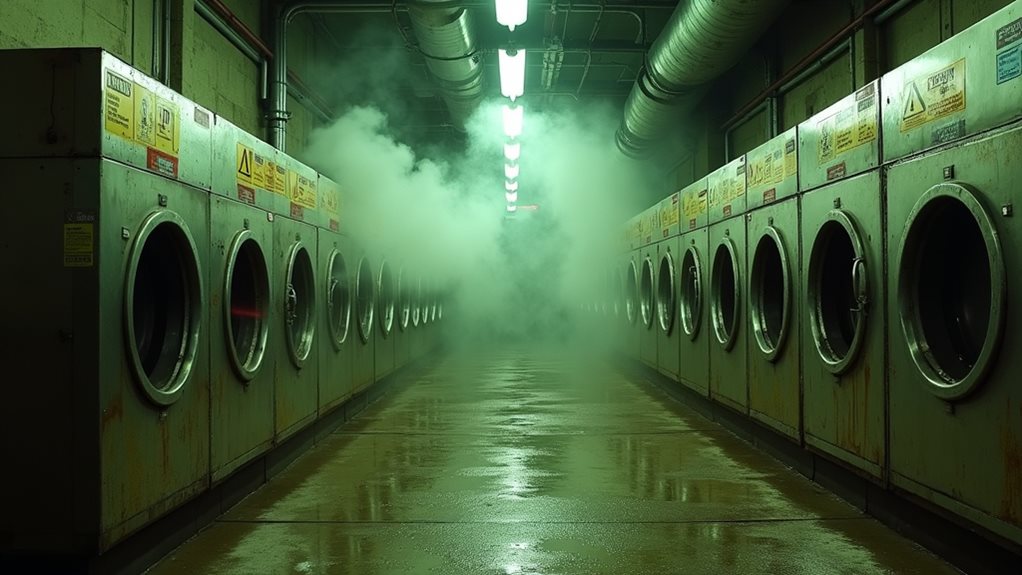
The health risks from perchloroethylene exposure aren’t just theoretical warnings on some government website—they’re real consequences affecting real people every day.
Workers breathing this probable carcinogen face dizziness, headaches, and long-term liver damage, while you’re unknowingly bringing home clothes that release toxic vapors into your living space.
Think about it: you’re paying someone to soak your garments in chemicals linked to multiple myeloma and non-Hodgkin lymphoma, then hanging them in your closet where environmental pollution becomes personal contamination.
These PERC residues can linger on freshly dry cleaned garments, particularly when clothes are not properly aired out, creating ongoing exposure risks for you and your family through skin irritation and respiratory problems.
Environmental Contamination and Groundwater Pollution

While you’re worrying about chemicals clinging to your favorite blazer, something far more sinister is happening beneath your feet—perchloroethylene doesn’t just disappear after it’s done “cleaning” your clothes.
This hazardous substance seeps through soil like a toxic ghost, contaminating groundwater supplies that entire communities depend on for drinking water.
I’ve seen neighborhoods where families can’t use their wells anymore because dry cleaners weren’t careful with disposal, and honestly, it breaks my heart 💔.
The Environmental Protection Agency didn’t label perc dangerous for fun—this chemical creates environmental pollution that lasts for decades.
When the EPA marks a chemical as hazardous, they mean it—perchloroethylene’s environmental damage spans generations, not years.
When you choose conventional dry cleaning, you’re inadvertently supporting an industry that’s poisoning the earth beneath us, affecting local ecosystems and wildlife in ways we’re still discovering.
Fortunately, safer alternatives like liquid CO2 cleaning and wet cleaning methods are becoming more available, offering hope for reducing this environmental devastation.
Cancer-Causing Agents on Your Clothing
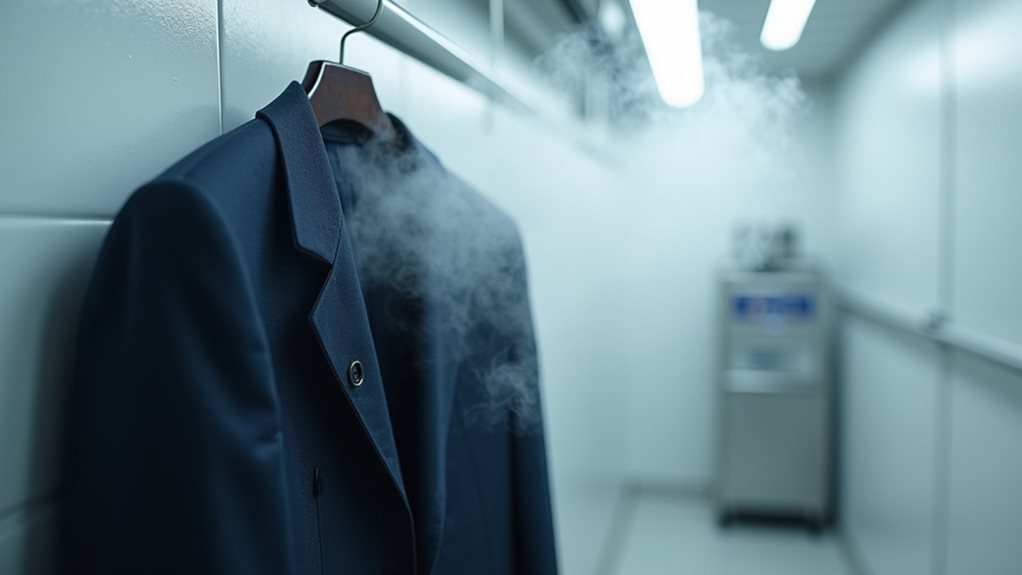
Every time you slip on that freshly dry-cleaned shirt, you’re fundamentally wrapping yourself in a garment that’s been bathed in perchloroethylene—a chemical that cancer researchers have flagged as a probable human carcinogen.
I know it sounds dramatic, but here’s the unsettling reality: those lingering fumes you smell aren’t just “clean”—they’re residual traces of perc that didn’t fully evaporate during processing.
Studies have connected this environmental toxin to multiple myeloma and non-Hodgkin lymphoma, which honestly makes me reconsider my fancy suit habits 😅.
The health risks compound with repeated dry cleaning sessions, as these cancer-causing agents accumulate in fabric fibers, creating a concerning cycle where looking professional might compromise your long-term wellbeing.
Research has also linked occupational exposure to increased risks of bladder, esophageal, and cervical cancers among dry cleaning workers.
Hidden Costs of Professional Cleaning Services

Beyond the health implications lurking in those chemical-soaked fabrics, your wallet takes a beating that most people don’t see coming until they’re already trapped in the dry cleaning cycle.
Those $7-$10 routine cleanings quickly balloon with hidden costs for stain removal, pressing, and alterations, creating bills that’ll make you wince.
When your favorite silk blouse gets damaged by perchloroethylene (perc), you’ll discover another nasty surprise – reimbursement at depreciated value, leaving you holding the bag financially.
Even switching to environmentally friendly dry cleaners doesn’t eliminate health risks from toxic chemicals completely, and those services often cost more.
The real kicker? Regular professional cleaning creates false confidence, encouraging careless handling at home, which ironically leads to more damage and higher costs.
Behind the scenes, dry cleaners must cover specialized equipment costs that can reach hundreds of thousands of dollars, plus expensive insurance coverage for chemical exposure claims, all of which gets passed directly to consumers.
Safe Alternatives to Traditional Dry Cleaning

When I first discovered that my supposedly “dry clean only” cashmere sweater could actually survive a gentle hand wash, it felt like uncovering a secret the fashion industry didn’t want me to know.
That moment when you realize the fashion industry has been keeping you dependent on expensive dry cleaning services all along.
You’d be amazed how many delicate fabrics respond beautifully to cool water and gentle detergent, saving you money while protecting your health from harsh chemicals.
For stubborn stains, spot cleaning with pH-neutral solutions works wonders without subjecting entire garments to chemical baths.
Steaming garments eliminates wrinkles, odors, and bacteria naturally—I swear by my handheld steamer for everything from silk blouses to wool coats.
When professional cleaning becomes necessary, seek services offering eco-friendly cleaning methods like liquid carbon dioxide, which provides thorough cleaning without environmental damage or chemical residue.
While avoiding traditional dry cleaning protects your health, business owners should note that dry cleaning expenses for specialized work uniforms or costumes may still qualify as legitimate tax deductions.
Fabrics You Can Wash at Home Instead
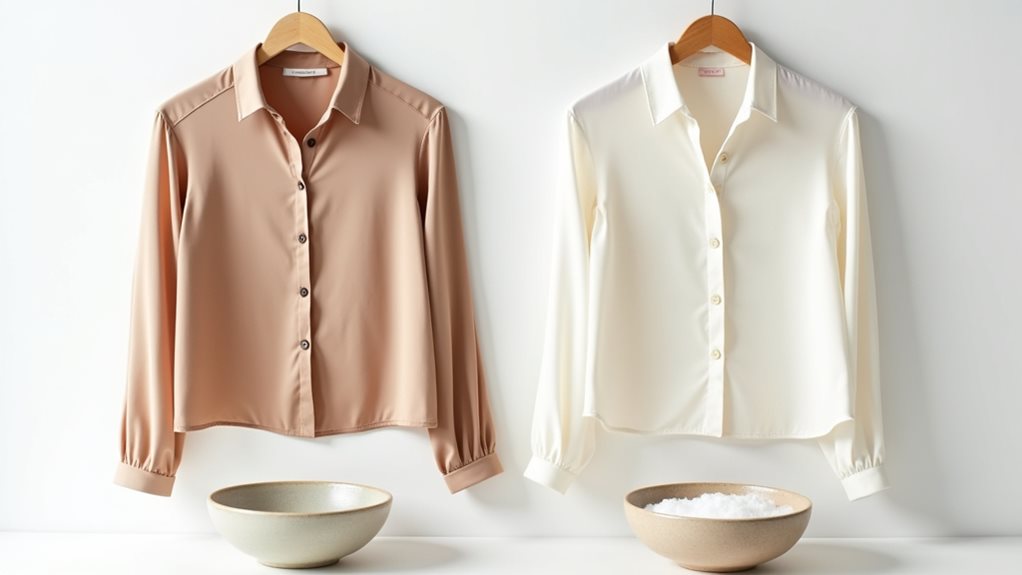
You’d be surprised how many items hanging in your closet with “dry clean only” tags can actually be washed at home with a little care and the right technique.
I used to religiously haul my cashmere sweaters and silk blouses to the cleaners every month until I discovered that gentle hand-washing not just saves money, but often keeps these delicate fabrics looking better than harsh chemical treatments ever could.
From your favorite cotton dress shirts to that wool coat you’re afraid to touch, most fabrics respond beautifully to home care when you understand their specific needs and follow a few simple guidelines.
The key is learning to distinguish between garments that are truly dry-clean-only due to their fabric composition and those that carry the label simply as a precautionary measure from manufacturers.
Cashmere and Silk Care
Although I spent years mindlessly dropping my favorite cashmere sweater and silk blouses at the dry cleaner, thinking I was giving them the royal treatment they deserved, I eventually discovered that these delicate fabrics actually prefer the gentle touch of home care over harsh chemical baths.
While dry cleaners use perchloroethylene and other aggressive solvents, hand-washing with tepid water and delicate detergent works wonders for both materials.
I’ve learned to wash my cashmere every seven to ten wears, and my silk pieces pass the scrunch test beautifully when treated gently at home.
Both fabrics should be air-dried on padded hangers to prevent stretching, and honestly, this gentle approach has helped extend lifespan notably while saving money! 💸
The truth is, many manufacturer care instructions that require dry cleaning are overly cautious, and with proper technique, you can maintain your delicate garments’ integrity at home.
Wool and Down Items
Since discovering that my bulky winter coat didn’t actually need those expensive dry cleaning trips, I’ve become something of a detective when it comes to wool and down care labels, often finding that manufacturers slap on “dry clean only” tags more out of legal caution than actual necessity.
You’d be amazed how many wool sweaters can actually be cleaned at home using cold water and your machine’s gentlest cycle – contrary to traditional dry cleaning wisdom that’s been drilled into us for decades.
Down items especially shouldn’t go to dry cleaners since harsh chemicals damage the delicate filling, but they wash beautifully at home on cold, gentle settings.
For wool coats, simple spot-cleaning and steam-pressing work wonders, saving you both money and unnecessary trips.
While dry cleaning uses chemical solvents instead of water to preserve fabric integrity, many wool and down items can withstand gentle home washing without the shrinkage or damage that dry cleaning advocates warn about.
Cotton Dress Shirts
While I used to religiously send every single dress shirt to the dry cleaner like some kind of corporate zombie 🤖, I’ve discovered that cotton dress shirts are actually among the easiest items to wash at home, requiring nothing more than cold water and a gentle cycle to stay crisp and professional-looking.
The care label might make you think these shirts need special treatment, but trust me, they don’t. I’ve been washing mine at home for years now, and they look just as effective as anything that’s been dry cleaned.
The secret is hanging them up immediately after washing, which prevents wrinkles without any fancy equipment or chemicals, plus adding an extra rinse cycle keeps your skin happy. Unlike dry cleaning which uses chemical solvents instead of water, home washing gives you complete control over the temperature and process to prevent any unwanted shrinkage.

